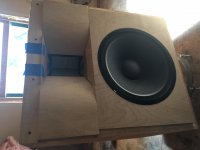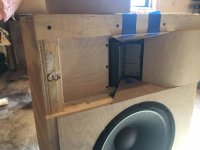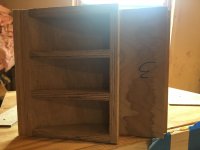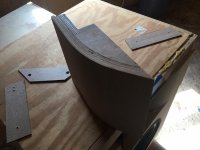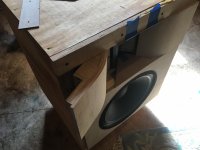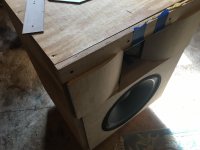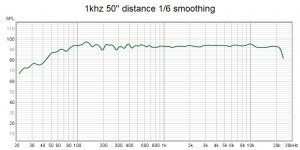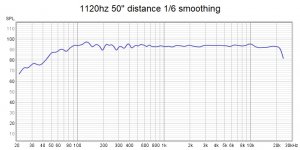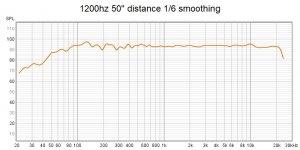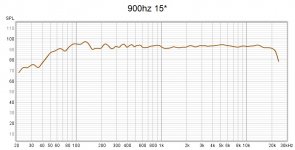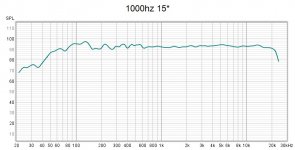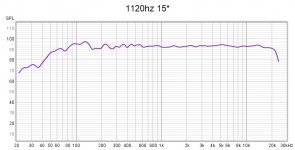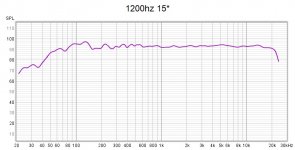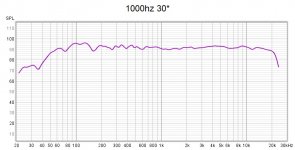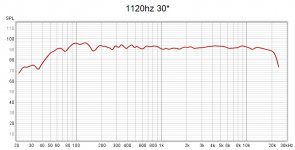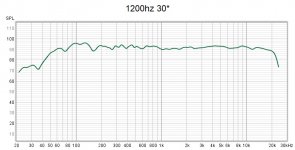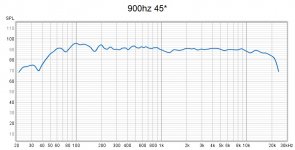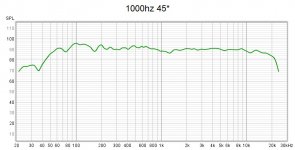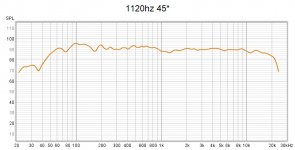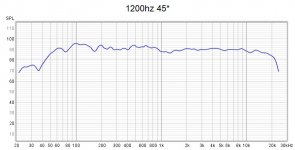Yes I did. I am not a big fan of dipole though, in my rooms at least. However I love the smaller round monopole Heil. I have them in a two way. These and the Aruum Cantus AST2650 is what made me really like AMT's sound. To my ears, they sound more real. I have not heard the G1 ribbons yet.
I've read numerous times, the round Heils were better sounding if crossed over at 2700 or higher, than their big brothers. I sure wish they had a big mono pole design!
I've read numerous times, the round Heils were better sounding if crossed over at 2700 or higher, than their big brothers. I sure wish they had a big mono pole design!
Flaxxer, I just got a pair of the heil amt II (med) and after discussing options with the owner (Rick) he said that one can make a V shaped block of wood with or without felt to cover the backside of any of the dipoles they make.
Not saying you should do that, just passing the info along.
I haven’t hooked them up yet but plan on trying them in every configuration possible.
Not saying you should do that, just passing the info along.
I haven’t hooked them up yet but plan on trying them in every configuration possible.
Last edited:
I've got a pair of the older Heils enclosed in a box mounted in a enclosure with a 15" driver. I fabricated a waveguide for it. The sides are flared using around a 8" radius form wrapped with 2 layers of 3/8" bending plywood.
The side flares really work to smooth the frequency response. The resulting "mouth" matches up to the 15" well enough. The thing I've noticed with the large Heil is that while it can be pushed down to 900hz LR4 it does sound a bit thin there .. in spots ... like on some voices. Now at 1khz LR4 it's pretty solid. I'm flipping between the 1khz setting and another at 1120hz. The higher setting uses more of the 15" driver but if you pick a good one it will have pretty good voicing here still. Even so, with either setting, the acoustic xo ends up in the 1.2-1.3khz range. The on axis response is really flat.
My 2cents, with a larger (15") AMT 2way, is that some try to push the xo too low. Pick a really good 15" woofer, one that can work up to 4khz or so and don't worry too much about the dispersion angle. A 12" might be a better match at the xo region but you lose some low end extension with it. Mine are sealed as this is what I prefer, ported may change that some with the 12" ... or add in some subs. At any rate, trying to shoehorn a 15" with the heil while trying to respect the "ideal" xo region will handcuff you. Don't get scared off of pushing the 15" a bit higher in this combination.
The side flares really work to smooth the frequency response. The resulting "mouth" matches up to the 15" well enough. The thing I've noticed with the large Heil is that while it can be pushed down to 900hz LR4 it does sound a bit thin there .. in spots ... like on some voices. Now at 1khz LR4 it's pretty solid. I'm flipping between the 1khz setting and another at 1120hz. The higher setting uses more of the 15" driver but if you pick a good one it will have pretty good voicing here still. Even so, with either setting, the acoustic xo ends up in the 1.2-1.3khz range. The on axis response is really flat.
My 2cents, with a larger (15") AMT 2way, is that some try to push the xo too low. Pick a really good 15" woofer, one that can work up to 4khz or so and don't worry too much about the dispersion angle. A 12" might be a better match at the xo region but you lose some low end extension with it. Mine are sealed as this is what I prefer, ported may change that some with the 12" ... or add in some subs. At any rate, trying to shoehorn a 15" with the heil while trying to respect the "ideal" xo region will handcuff you. Don't get scared off of pushing the 15" a bit higher in this combination.
So the back of the dipole Heil is opened to the inside of the enclosure with the 15" woofer? That sounds strange.
As far as xover points ... in my opinion everyone tries to play the Heils too low. Even ESS has the xover for handing off to their speakers with a 10" woofer at 2400hz for the small Heil. It needs 2700, and prefers 3000.
Same with the large Heil. Cross it over at 1500 and let it play WITHOUT strain down low. It opens up the top end. We did this at a friend's place a couple of years ago. Made all the difference.
As far as xover points ... in my opinion everyone tries to play the Heils too low. Even ESS has the xover for handing off to their speakers with a 10" woofer at 2400hz for the small Heil. It needs 2700, and prefers 3000.
Same with the large Heil. Cross it over at 1500 and let it play WITHOUT strain down low. It opens up the top end. We did this at a friend's place a couple of years ago. Made all the difference.
Just where anyone reading this knows ... As the OP, a couple of my listening rooms require the speakers closer to the side walls than optimal. Anything like a dipole is too much for these rooms.
No Flaxxer ... the heil is in it's own box which is mounted inside the 15" bass enclosure. The back side of the heil's box is closed off.
I think the crossover with large Heil AMT is a compromise, as so many things with speakers. I also notice that top high stays fresher with a higher crossover. On the other hand, the AMT is so fast and clean that you want it to cover a large range. And having one driver doing all sound above say 1.2k helps stereo placement as well...
I used what's commonly referred to as a ruler 🙂I see. How did you go about figuring what size box to place the Heil in?
Seriously though, The box inside width is the heils width plus a hair and the height I made an inch taller than the heil, so around 7" inside. Depth was the same as the heil. Since it has the 90 degree built in "horn" I figured that area was enough space to infill with damping. Box is 1/2" BB. The back cover is removable.
The height worked out to fit the waveguide section at the baffle face which is 8" tall ... same OD height of the heil box. It's recessed into the bass enclosure to sort of time align the drivers and make up for the radius of the waveguide so it, the waveguide, comes flush with the baffle face.
I did things this way so if I decided to go with a CD/horn later on I could without too much grief. The bass enclosure is similar to Yuichi's Loudspeaker Enclosure
Now imagine the enclosure flipped over and an 8" section cutout across the width ( right at the ports, which I don't use). All the heil stuff happens in that 8" high space, full width of the enclosure. The 8" height also allows for about 1-5/6" top and bottom to transition to the baffle ... I'm still working that part out as to whether that needs to be a radius too or just a chamfer from the baffle face to the top/bottom of the heil. The heil vertical is tight, as you know, and an additional radius here might not make all that much difference. It measures fine as it is. The waveguide mouth height will still be 8" either way.
Last edited:
No sane soundingeneer would listen that loud uncompressed. Usin compression has its reasons. Why would a profesional risk his or her livelihood listening that loud. Years ago it was common yes. Now we know to use rubber or get hearingaidsAndy,
I wasn't accurate enough in what i wrote. I should have stated it's a worst case scenario from the point of power requirement in that with wide dynamic range material ( which in my view is a good things if the genre of music require it) this requirements are the most demanding/severe/worst.
I think most amateurs doesn't get the studio systems aren't operated full open gain 95% of the time. That said for the 5% when you need an accurate reproduction of what you track at 'realistic' level (to assess choices to be made during production) you really need the system to be able to deliver ( when a drumer have to check his take just after playing it and he insist to listen at same level he performed- no need to say i just used hear protection or leaved the room in my days in studio!).
More people should stay just behind an irritated drumer for just a song. Then imagine how loud have to be a loudspeaker system to reproduce this at 3/4 meters distance. The requirements are huge ( for efficiency and power to drive).
Of course it can be seen as a waste as this is not used this much but rather think of headroom gain. It garantee that the system will mitigate issues about power compression, dynamic ( if there is still in the message) won't be compomised by the loudspeakers on lower dynamic range material. Overall it will increase the sense of ease in the reproduction.
3m to 3,5m is what i've seen the most in professional control room from 70's to 90's. This ask for big rooms. I've been in one place ( early 90's designed iirc) where the system had 4m distancebut the room was huge ( a place where international famous artists were common customers).
Since 2000 control room size never seems to stop decreasing ( same trend as the amount of money imparted to production).
And i share your view.
But keep in mind i'm an happy few who doesn't have to take into account waf or neighbours... which helps to have 'big' box ( the down side of it to me).
Cheers
I used what's commonly referred to as a ruler 🙂
Ruler? Never heard of it. 😉
Looks like an interesting project.
Hope to get it completed one of these days ... 🙂 Always something else comes up. Too many projects for a guy my age.
puppet :
FR / spl charts please, I bet there's a deep valley in the middle.
I've heard a lot of Heil's originals on AMT 1 and its other variants. Invariably the mid zone lacked realism on drums, the vocals were soft, yes. But a Heil tweeter can't go so low that it gets close to the midrange of a 15 " twoofer in my opinion.
And losing the back wave of the AMT I think makes things worse.
FR / spl charts please, I bet there's a deep valley in the middle.
I've heard a lot of Heil's originals on AMT 1 and its other variants. Invariably the mid zone lacked realism on drums, the vocals were soft, yes. But a Heil tweeter can't go so low that it gets close to the midrange of a 15 " twoofer in my opinion.
And losing the back wave of the AMT I think makes things worse.
how-much-amplifier-power-do-i-really-need - YouTube
Alan Shaw and the guys keep on saying about Pan Sonic 'Laptev Sea' track it is 'dynamic' ( 1:01, 1:30,...).
Well... no dynamic it's not. Loud it is yes.
In fact the whole demonstration is the inverse of what i talked about: monitor level is set at constant volume and the loudness difference between tracks is the native 'loudness' of the material.
The sonata used have more dynamic but it can't be portraiyed as the passage with dynamic part have been dimed ( attenuated) during Alan Shaw talk at the end of video... that said the display of power showed already a ratio of almost 5 ( around 6w average with peaks around 30w) instead of the 1,5 ratio during Laptev Sea ( 500w average, 750w peaks).
I like Pan Sonic a lot ( but prefer their early works) but in no way i would call their music dynamic. Loud yes. If anyone doubt it: DR is 7db on this track.
Album details - Dynamic Range Database
I disagree about their conclusion too: for me the test conclude that louder is ... louder. One thing they demonstrated though is that non efficient loudspeakers needs a lot of watts.
And that an Amethist does a great job at transparent FIR processing and high pass ( Kudo to Trinnov).
One last thing, the level they played Pan Sonic track can be guess estimated @ around 112dbspl @1m.
( 85dbspl + 27db / efficiency+500w).
With a DR of 7db and guessestimated a listening distance of 3m ( minus 9db) it gives an rms level in the vicinity of 96dbspl average/rms level.
It is 10db more than the target level of 85dbspl we discussed as reference. At 'subjective' feeling it is equivalent to perceived halving of the level.
It'll let take your own conclusions on this from the recording during the video : the fact they talk to each others is a good clue to interpret volume imho as well as the non clipping camera recording.
Of course i doesn't agree about the low wattage amps conclusions too: it's true for this Harbeth's Monitors with a more efficient loudspeaker 5w could be more than enough for a mid/high way in my view.
For low range if you want some lows to be reproduced you need many many more but that's me, my habits and bad preference regarding music genre/style.
Pan Sonic i usually consider to be mildly annoying regarding low end. I've got far more annoying tracks regarding low end within my own collection ( and not all are underground weirdos music/noise -depends on your view).
Guerilla,
Thank you pointing to me i'm not unsane. And that i'm a thing of the past as a reminder! 🙂
Please reread the message you quoted: i though it was obvious the requirements for realistic levels was not from engineers but from artists/musicians ( '...a drummer insist to monitor at realistic level ...just after a take').
And the confirmation i'm not unsane ('i used my hear protection or run outside the room')!
Talking about professionals artists some of them are so deaf they choose the studio they'll work into on the criteria of max spl at desk achievable!
I could list you some guys/girls ( french artists but not only) but as i'm supposed to be stealth about this i will take an example everyone know and who publicly explained he could not fell asleep without a tv or radio playing loud to cover tinitus: James Hetfield ( Metallica's singer/ guitarist/ composer).
This kind of clients ask for things which are not sane i agree but those are clients (with inflated ego) and they are kings of people they hire...
The huge studio i talked about in the message is the A from OMega ( Suresnes, France):
Les studios Omega parisiens rachetes par l'Abbey Road Institute France pour son centre de formation - Audiofanzine
Can't remember exactly how much power is used to drive the thing ( but if you want to know i could give a phone call to Jean-Phi - now director of Abbey Road institute Paris- which is a former colleague and could tell me exactly what is used in this room amps are Bryston iirc).
The place was built by the ( renowed) engineer which ( worked for the 'mainstream' french artists) owned the room in 90's and the system requirements was 120db clean peak at listening position ( a way to attract international customers).
Ok now i would like to know how compression could protect my ears? In my understanding compression happen on rms level ( which we use to evaluate overall perceived level). Peaks are so shorts they usually are not considered as 'important' wrt perceived level ( and this led to loudness war).
We destroy our ears by prolongated exposure to high rms level not by peaks.
So please explain me how i could protect my listening through compression?
I gave the answer which seems the most reasonnable to me ( Bob Katz's K system implementation which underlying principle is known as 'leveling'- now used by all online music platform service as a reminder ), but maybe something more astute is now used?
I must say i'm surprised by the reaction to this as this approach has drawbacks ( like everything in life) and thought it was what would bother people/ generate reaction, but these was not what happened so i'll leave to curious mind to find it ( there is only one drawback to this approach and it's not different to what broadcast face).
This brings back to Mettalica's 'death magnetic's' and deaf artists: first release of 'death magnetic's' (2008) was greatly critisised as it clipped. Yes beside the distording guitars clipping was audible and peoples complained directly to mastering engineer thru social networks, phone calls,... he finally decided to answer that as someone hired he executed what his client asked ( beside having warned them on drawbacks). Deaf clients, multibands compression/limiters mastering gear led to 3db DR.
Album details - Dynamic Range Database
As Metallica is great to his audience they graced people with a modified mastering release to a 6db DR! Nice, at least it doesn't clip this much as the first one ( but your ears are still in danger thanks to the high rms level ).
Of course all this is MY view on all this and in no way i think to have universal knowledge or that my preference should rule the world. So no need to start a war if you disagree, better talks to each others and accept preferences as preferences.
Alan Shaw and the guys keep on saying about Pan Sonic 'Laptev Sea' track it is 'dynamic' ( 1:01, 1:30,...).
Well... no dynamic it's not. Loud it is yes.
In fact the whole demonstration is the inverse of what i talked about: monitor level is set at constant volume and the loudness difference between tracks is the native 'loudness' of the material.
The sonata used have more dynamic but it can't be portraiyed as the passage with dynamic part have been dimed ( attenuated) during Alan Shaw talk at the end of video... that said the display of power showed already a ratio of almost 5 ( around 6w average with peaks around 30w) instead of the 1,5 ratio during Laptev Sea ( 500w average, 750w peaks).
I like Pan Sonic a lot ( but prefer their early works) but in no way i would call their music dynamic. Loud yes. If anyone doubt it: DR is 7db on this track.
Album details - Dynamic Range Database
I disagree about their conclusion too: for me the test conclude that louder is ... louder. One thing they demonstrated though is that non efficient loudspeakers needs a lot of watts.
And that an Amethist does a great job at transparent FIR processing and high pass ( Kudo to Trinnov).
One last thing, the level they played Pan Sonic track can be guess estimated @ around 112dbspl @1m.
( 85dbspl + 27db / efficiency+500w).
With a DR of 7db and guessestimated a listening distance of 3m ( minus 9db) it gives an rms level in the vicinity of 96dbspl average/rms level.
It is 10db more than the target level of 85dbspl we discussed as reference. At 'subjective' feeling it is equivalent to perceived halving of the level.
It'll let take your own conclusions on this from the recording during the video : the fact they talk to each others is a good clue to interpret volume imho as well as the non clipping camera recording.
Of course i doesn't agree about the low wattage amps conclusions too: it's true for this Harbeth's Monitors with a more efficient loudspeaker 5w could be more than enough for a mid/high way in my view.
For low range if you want some lows to be reproduced you need many many more but that's me, my habits and bad preference regarding music genre/style.
Pan Sonic i usually consider to be mildly annoying regarding low end. I've got far more annoying tracks regarding low end within my own collection ( and not all are underground weirdos music/noise -depends on your view).
Guerilla,
Thank you pointing to me i'm not unsane. And that i'm a thing of the past as a reminder! 🙂
Please reread the message you quoted: i though it was obvious the requirements for realistic levels was not from engineers but from artists/musicians ( '...a drummer insist to monitor at realistic level ...just after a take').
And the confirmation i'm not unsane ('i used my hear protection or run outside the room')!
Talking about professionals artists some of them are so deaf they choose the studio they'll work into on the criteria of max spl at desk achievable!
I could list you some guys/girls ( french artists but not only) but as i'm supposed to be stealth about this i will take an example everyone know and who publicly explained he could not fell asleep without a tv or radio playing loud to cover tinitus: James Hetfield ( Metallica's singer/ guitarist/ composer).
This kind of clients ask for things which are not sane i agree but those are clients (with inflated ego) and they are kings of people they hire...
The huge studio i talked about in the message is the A from OMega ( Suresnes, France):
Les studios Omega parisiens rachetes par l'Abbey Road Institute France pour son centre de formation - Audiofanzine
Can't remember exactly how much power is used to drive the thing ( but if you want to know i could give a phone call to Jean-Phi - now director of Abbey Road institute Paris- which is a former colleague and could tell me exactly what is used in this room amps are Bryston iirc).
The place was built by the ( renowed) engineer which ( worked for the 'mainstream' french artists) owned the room in 90's and the system requirements was 120db clean peak at listening position ( a way to attract international customers).
Ok now i would like to know how compression could protect my ears? In my understanding compression happen on rms level ( which we use to evaluate overall perceived level). Peaks are so shorts they usually are not considered as 'important' wrt perceived level ( and this led to loudness war).
We destroy our ears by prolongated exposure to high rms level not by peaks.
So please explain me how i could protect my listening through compression?
I gave the answer which seems the most reasonnable to me ( Bob Katz's K system implementation which underlying principle is known as 'leveling'- now used by all online music platform service as a reminder ), but maybe something more astute is now used?
I must say i'm surprised by the reaction to this as this approach has drawbacks ( like everything in life) and thought it was what would bother people/ generate reaction, but these was not what happened so i'll leave to curious mind to find it ( there is only one drawback to this approach and it's not different to what broadcast face).
This brings back to Mettalica's 'death magnetic's' and deaf artists: first release of 'death magnetic's' (2008) was greatly critisised as it clipped. Yes beside the distording guitars clipping was audible and peoples complained directly to mastering engineer thru social networks, phone calls,... he finally decided to answer that as someone hired he executed what his client asked ( beside having warned them on drawbacks). Deaf clients, multibands compression/limiters mastering gear led to 3db DR.
Album details - Dynamic Range Database
As Metallica is great to his audience they graced people with a modified mastering release to a 6db DR! Nice, at least it doesn't clip this much as the first one ( but your ears are still in danger thanks to the high rms level ).
Of course all this is MY view on all this and in no way i think to have universal knowledge or that my preference should rule the world. So no need to start a war if you disagree, better talks to each others and accept preferences as preferences.
Last edited:
I'll try to get something posted today. You might be surprised though.puppet :
FR / spl charts please, I bet there's a deep valley in the middle.
I've heard a lot of Heil's originals on AMT 1 and its other variants. Invariably the mid zone lacked realism on drums, the vocals were soft, yes. But a Heil tweeter can't go so low that it gets close to the midrange of a 15 " twoofer in my opinion.
And losing the back wave of the AMT I think makes things worse.
30* and 45* off
All in room, quick and dirty 🙂
All in room, quick and dirty 🙂
Attachments
- Home
- Loudspeakers
- Multi-Way
- I'm building a $4000 speaker kit ... Which one?
